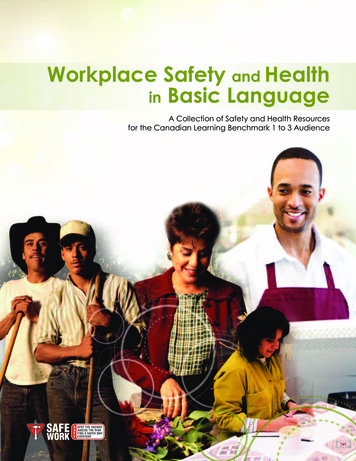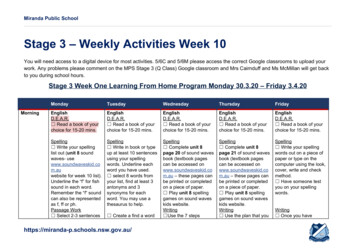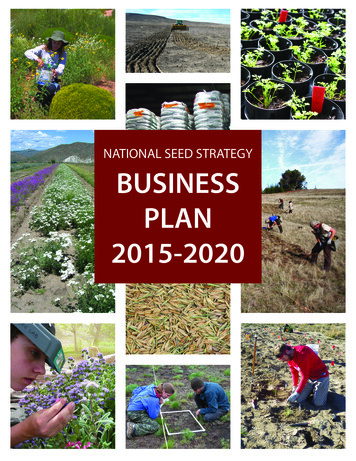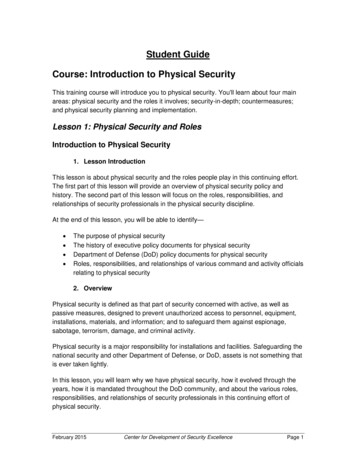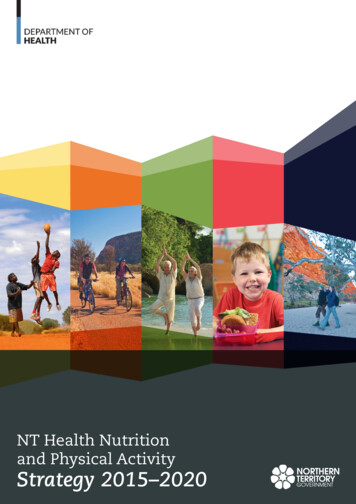
Transcription
NT Health Nutritionand Physical ActivityStrategy 2015–2020
DEPARTMENT OF HEALTHContentsForeword 2Acronyms 5Who is this strategy for and howcan it be used? 6Aim 6Objectives 6Objective 3: optimise feeding practicesand promote an active lifestyle forchildren aged 0 5 years Background 24What the data tell us 25Our challenge 26Evidence for effective interventions 26Suggested strategies across settings 28Indicators 28Stakeholders* 29Key action areas and target group 6Related policies, strategies and guidelines 7Guiding principles 7Working within a healthpromoting framework 7Targeting the social determinants of health 7Gender and diversity 7Background 30Providing cultural security 8What the data tell us 31Sustaining through capacity building 8Our challenge 33Working in partnership 8Evidence of effective interventions 33Commitment to monitoring and evaluation 8Suggested strategies across settings 349Indicators 35Stakeholders* 35Summary of strategies Objective 1: improve food security,particularly in remote communities 14Background 14What the data tell us 14Objective 4: promote and support healthyeating and regular participation in physicalactivity among school aged children Objective 5: achieve and maintain ahealthy weight for all adults and olderTerritorians 3036Our challenge 16Background Evidence of effective interventions 16What the data tell us 37Suggested strategies 16Our challenge 41Indicators 17Evidence of effective interventions 4117Suggested strategies across settings 42Indicators 44Stakeholders* 44Stakeholders* Objective 2: promote and support ahealthy diet and a healthy weight amongwomen of child bearing age 18Background 18What the NT data tell us 20Our challenge 21Evidence of effective interventions 21Suggested strategies across settings 22Indicators 22Stakeholders* 2236Appendix A: Australian Dietary Guidelines 45Appendix B: Australia’s physical activityand sedentary behaviour guidelines 46National Physical Activity Recommendationsfor Children 0 5 years 46Physical Activity and Sedentary BehaviourGuidelines for 5 12 and 13 17 year olds9;12 46Physical Activity and Sedentary BehaviourGuidelines for 18 64 year olds11 47Physical Activity Recommendations forOlder Australians10 References 2244748
NT Health Nutrition and Physical Activity Strategy 2015–2020AODAlcohol and other DrugsABSAustralian Bureau of StatisticsAHPAboriginal Health PractitionerALPAArnhem Lands Progress Aboriginal CorporationCNWCommunity Nutrition WorkerCYHChild and Youth HealthDETDepartment of EducationDLPEDepartment of Lands, Planning and the EnvironmentDSRDepartment of Sport and RecreationGPGeneral PractitionerMBSMarket Basket SurveyMSHRMenzies School of Health ResearchNHMRCNational Health and Medical Research CouncilOBSOutback StoresPHCPrimary Health CareRMPRemote Medical PractitionerRNRegistered NurseSWSBSCStrong Women Strong Baby Strong CultureSWWStrong Women WorkerWHSUWomen’s Health Strategy UnitMHSUMen’s Health Strategy UnitSTRATEGY SUMMARYAcronyms3
DEPARTMENT OF HEALTH4
NT Health Nutrition and Physical Activity Strategy 2015–2020Foreword“It is no secret that healthynutrition and regularphysical activity are criticalto good health.”These issues present significant publichealth problems that threaten the gainsmade in earlier decades. They also place anincreasing burden on health budgets andgovernments in general.The Northern Territory (NT) has not beenimmune to these developments and is nowfacing high rates of chronic diseases. Butwhilst we have an urgent responsibility to acton overweight and obesity, we must also tackleother nutrition issues, such as underweightand anaemia among young children inremote communities. As we all know, theseissues must be addressed in the contextof geographic isolation, limited enablinginfrastructure, and staff turnover.With these challenges in mind, this strategydraws on the available evidence to proposelocal solutions to NT specific problems.It contains a comprehensive list of suggestionsfor staff who are able to influence thedeterminants of a healthy and active lifestyle,whether these staff work in a policy contextor ‘at the coal face’. It also leaves room forinnovative and community driven responses.As most contributing factors to poor nutritionor physical inactivity are outside the controlof the Health sector, many of the proposedsolutions will require collaboration with othersectors, within and outside government.The strength of the NT is that in many cases,these alliances already exist and are solid;much good work can therefore be expectedby capitalising on them.Finally, this strategy is grounded on healthpromotion principles; it acknowledges the rolethat environments play in shaping individuals’decisions and aims to develop the conditionsthat will support changes. Only by making iteasier for people to make healthy choices inthe places they live, work and play, can wehope to turn the rising tide of chronic diseases.I thank all of those who gave their time andattention to the development of this importantdocument. It is with great pleasure that Icommend to you the NT Health Nutrition andPhysical Activity Strategy 2015 2020.Professor Len Notaras AMChief ExecutiveSTRATEGY SUMMARYIt is no secret that healthy nutrition and regularphysical activity are critical to good health.Yet, for most of us, choosing healthier foodsand drinks and finding time to exercise hasnever been harder. Not surprisingly rates ofoverweight and obesity are high, and rising,causing an alarming increase in prevalence ofdiabetes and chronic diseases.5
DEPARTMENT OF HEALTHWho is this strategy forand how can it be used?Key action areas andtarget groupThe Northern Territory Health (NT Health)Nutrition and Physical Activity Strategy2015 2020 (‘the strategy’) is intended forstaff within NT Health who are in a position toinfluence the determinants of a healthy dietand an active lifestyle. Reduce obesogenic environments bydeveloping policies and environmentsthat support healthy eating and regularphysical activity.It provides an overview of the key health issuesassociated with poor nutrition and physicalinactivity throughout the life course, bringstogether the available evidence of interventionsthat have been effective in addressing them,and suggests a range of strategic actionsrelevant to the NT context.- exclusive breastfeeding for the first6 months of lifeIn practice, this strategy can be used as aguide and practical tool for planning andevaluation across the spectrum of programsthat have a remit in nutrition and physicalactivity. It complements the NorthernTerritory Chronic Conditions Prevention andManagement Strategy 2010 2020¹ andsupports its implementation.- reduced intake of sugar sweetenedbeverages (SSBs)AimThis strategy aims to increase the proportion ofTerritorians who enjoy a balanced diet, lead anactive lifestyle and maintain a healthy weight,in order to enhance their health and wellbeing,and reduce the risk and incidence of chronicdiseases and premature death.ObjectivesObjective 1: improve food security, particularlyin remote communities.Objective 2: promote and support a healthydiet and a healthy weight among women ofchild bearing age.Objective 3: optimise feeding practices andpromote an active lifestyle for children aged0 5 years.Objective 4: promote and support healthyeating and regular participation in physicalactivity among school aged children.Objective 5: achieve and maintain a healthyweight for all adults and older Territorians.6 Promote healthy eating by encouragingand supporting- the introduction of age appropriatesolids at around 6 months- increased consumption of fruit andvegetables- reduced intake of other energy-densenutrient-poor (EDNP) foods and drinks. Promote participation in regular physicalactivity throughout life. Promote a reduction in time spent beingsedentary or sitting down.This strategy targets all Territorians, whereverthey live. It places however a special emphasison Aboriginalª people living in remotecommunities due to the higher burden ofdisease and disadvantage they experience.Related policies,strategies and guidelines 2014 2017 Strategic Plan, NorthernTerritory Health² Northern Territory Chronic ConditionsPrevention and Management Strategy2010 2020¹ Northern Territory Work Health and SafetyAct 2011³ Australian National Breastfeeding Strategy2010 20154 National Women’s Health Policy 20105 National Male Health Policy 20106 Australian Dietary Guidelines7 Australian Physical ActivityRecommendations and Guidelines.8-¹²a Throughout this document the term Aboriginal should be taken to include Torres Strait Islander people
NT Health Nutrition and Physical Activity Strategy 2015–2020Working within a healthpromoting frameworkConsistent with NT Health’s Health PromotionFramework13, this strategy promotes acontinuum of health promotion practice.This continuum is reflective of the OttawaCharter14 and relies on a range of approaches,both individual and population-wide, designedto complement one another as they target thedeterminants of health across the life course.These approaches include: settings and supportive environments community action health information and social marketing health education and skills development screening and individual risk assessment.Targeting the socialdeterminants of healthThis strategy acknowledges the need toaddress the multiple underlying social,economic and cultural determinants of healthand aims to reduce health disparities seen inthe NT, by focussing on those who experiencethe greatest disadvantage and are most at-risk.Hence its strong focus on Aboriginal peopleliving in remote communities, and particularlyon Aboriginal children under the age of two.Gender and diversityThis strategy recognises other causal factorsof health inequity including: age; ethnic andlinguistic background; gender; incarceration;mental health status; physical and orintellectual disability; and sexuality.Providing cultural securityConsistent with NT Health’s Aboriginal CulturalSecurity Policy15, this strategy promotes theprovision of culturally secure services that identify those elements of Aboriginalculture that affect the delivery of healthand community services in the NorthernTerritory review service delivery practices to ensurethat they do not offend Aboriginal people’sculture and values act to modify service delivery practiceswhere necessary monitor service activity to ensure that ourservices continue to meet culturally safestandards.This approach is extended to the provisionof services to communities of culturally andlinguistically diverse backgrounds.Sustaining through capacity buildingA key element to the sustainability of allinitiatives identified in this strategy is thebuilding of capacity, within the communityor other agencies. Capacity buildingencompasses training and support, sharingknowledge, assisting with ensuring that theinfrastructure is in place, addressing the issueof sustainability and facilitating the process ofproblem solving and evaluation.Working in partnershipImplementation of this strategy will be ashared responsibility between a broad rangeof stakeholders across the three entitiesforming the Public Health system in the NT.Many of the factors that impact on food supply,nutrition or physical activity are howeveroutside the responsibility of the health system.For sustained improvements in these domains,partnerships must therefore be establishedbetween relevant stakeholders across all levelsof government, the non-government sector,research institutions, industry andthe community.Commitment to monitoringand evaluationThe Nutrition and Physical Activity StrategyUnit will monitor performance against theobjectives at mid-term and five years, andcarry out the final evaluation.STRATEGY SUMMARYGuiding principles7
DEPARTMENT OF HEALTHSummary of strategiesObjective 1: improve foodsecurity, particularly in remotecommunitiesIn remote communities Develop community capacity to influenceavailability, variety, quality and affordabilityof core foods at the store. Assist store/takeaway management andstore committees to develop and implementfood and nutrition policies. Provide advice and learning opportunitiesto store staff to develop and implementinitiatives that improve food supply andconsumption of healthy food. Contribute to store-based activities thatpromote and support a healthy diet. Engage with Outback Stores (OBS),Arnhem Land Progress AboriginalCorporation (ALPA) stores and other keyfood industry stakeholders to contribute totheir efforts to ensure that the food supplysupports the Australian Dietary Guidelines7(see Appendix A page 43). Support research related to food systemsand factors that influence purchasing andconsumption decisions. Build on existing housing initiatives toimprove community and household foodpreparation and storage facilities. Advocate for initiatives to improve theaffordability of healthy food and drinks(e.g. cross-subsidisation).Across the NT Work with Community Stores Licensing(Australian Government) to ensureavailability of a range of affordable andhealthy food in all stores. Work with relevant government agencies,as well as the agriculture, horticultureand aquaculture industry, to supportthe development of sustainable andeconomically viable projects. In partnership with local communityorganisations, the non-government sectorand Aboriginal organisations, supportcommunity and school gardens, wherecommunity capacity and willingness tosupport the sustainable implementation of agarden project are demonstrated. Contribute to projects researchingoptions to improve food security indisadvantaged areas.Objective 2: promote andsupport a healthy diet and ahealthy weight among womenof child bearing agePre-pregnancy With adolescent females of child bearingage, emphasise the importance of healthyand balanced nutrition; in particular,promote a diet high in iron-rich foods. Referto contraception counselling as required. Promote folic acid and iodine supplementsfor all women planning a pregnancy (seeFigure 3 page 21). Develop and implement weightmanagement programs for women ofchildbearing age who are overweightor obese. Encourage smoking cessation.During the pregnancy and the first6 weeks post-natal Encourage regular attendance atantenatal clinics. Incorporate specific weight managementadvice as part of regular antenatal care.In particular, counsel teenagers on theimportance of adequate weight gainduring pregnancy. Promote key nutritional recommendationsfor pregnancy (see Figure 3 page 21). Encourage regular physical activity tomaintain general fitness and for goodblood glucose control in those womenwith diabetes. Promote smoking cessation and encouragewomen not to drink alcohol duringpregnancy and lactation.8
NT Health Nutrition and Physical Activity Strategy 2015–2020Key focus Systematic promotion of exclusivebreastfeeding for the first 6 months. Counselling about the introduction ofappropriate solids at around 6 months. Early identification and action on growthfailure, anaemia or overweight. Promotion of regular physical activity andlimited screen time.Within the health sector Implement the National BreastfeedingStrategy4: develop an NT action andimplementation plan. Integrate the systematic promotion ofbreastfeeding into key messages andpractice for all health professionals. Develop and/or enhance systematicdata collection and reporting ofbreastfeeding rates. Identify growth failure, overweight, obesityand anaemia early and ensure adequatefollow up. Contribute to national initiatives seekingto reduce exposure to television or screenbased advertising of energy dense nutrientpoor foods to children.In the home/families/community Promote exclusive breastfeeding up to6 months. Ensure that messages provided to parentsabout breastfeeding and introduction ofsolids are consistent with the Infant FeedingGuidelines.97 Create supportive community environmentsfor the development of healthy eatingbehaviour, including breastfeeding. Build remote communities’ capacity tosupport and promote the introduction ofsolids and the development of healthyfeeding practices. Work with store managers to ensurethat displays of infant formula, bottlesand teats are consistent with theMarketing in Australia of InfantFormulas (MAIF) Agreement.98In early childhood centres Provide education and assistance indeveloping a nutrition policy and menuplanning, consistent with the Infant FeedingGuidelines97 and the requirements of theAustralian Children’s Education and CareQuality Authority.Objective 4: promote andsupport healthy eating andregular participation inphysical activity among schoolaged childrenIn schools Promote and support the implementationof the NT Schools’ Canteen, Nutrition andHealthy Eating Policy.139 Contribute to the development of strategiesthat reduce energy-dense, nutrient-poor(EDNP) foods and drinks in lunch boxes. Provide advice, training and support toteaching staff to deliver nutrition educationin schools. Provide advice on the development ofcurriculum related resources that promotenutrition and physical activity and healthybody image. Advocate for the training of generalistteachers in fundamental movement skillsand physical education in general. Advocate for strategies that willincrease adolescent girls’ participationin physical activity.STRATEGY SUMMARYObjective 3: optimise feedingpractices and promote anactive lifestyle for childrenaged 0 5 years9
DEPARTMENT OF HEALTH Advocate for and support active transportto school. Advocate for active playgrounds andopportunities for incidental activitythroughout the day. Contribute to the establishment of schoolbased gardens. Contribute nutritional advice to Out-ofSchool Care programs, as required.In other settings Support local government to develop andimplement childhood obesity preventionprograms (e.g. COPAL in Palmerston). Provide training and support to healthprofessionals on child nutrition, physicalactivity and healthy body image,consistent with current guidelines andrecommendations. Promote the Australian Dietary Guidelinesfor Children7 and the Australianrecommendations for physical activity forchildren9;12; suggest home-based strategiesto implement them. Develop partnerships with Good Sports andkey sporting bodies to reduce access to,and promotion of, EDNP foods and drinksat sporting events. Promote ‘child friendly by design’approaches to influence the developmentof the built environment and public openspaces so that they incorporate safe activeplay and transport options. Research and implement innovativestrategies to include fathers in nutrition andphysical activity promotion. Contribute to national initiatives seeking toreduce exposure to advertising of EDNPfoods and drinks to children.Objective 5: achieve andmaintain a healthy weight forall adults and older TerritoriansWithin the health sector Create workplace environments wherehealthy eating and physical activity areeasily achievable:- implement 'Healthy choices madeeasy’, NT Healthy food and drinksprovision policy- develop and implement anActive@work policy- promote and support active transport toand from work- promote breaks in sedentary time. Strengthen the capacity of healthprofessionals to address overweight andobesity by:- promoting awareness of the risksassociated with weight gain andthe need to address even modestweight gain- promoting the NHMRCrecommendations for the managementof overweight and obesity in adults,children and adolescents. Ensure that the NTG leads by example,by advocating for the adoption of the NTHealthy food and drinks provision policyacross all NTG agencies. Advocate for, and actively contribute to,the development of government policiesthat have a positive impact on thedeterminants of overweight and obesity(e.g. food/active transport policy at nationaland Territory level). Advocate for the integration of Healthy byDesign principles177 in urban developments. Advocate for the shared use of facilities thatprovide opportunities for physical activity(e.g. school grounds). Contribute to national efforts seekingthe stronger regulation of marketing ofunhealthy foods and drinks, particularlyEDNP products.10
NT Health Nutrition and Physical Activity Strategy 2015–2020 Advocate for, and support, AustralianGovernment regulatory initiatives in foodreformulation and labelling to supporthealthier eating.In the community Increase community awareness of theneed to eat well and be active throughsocial marketing- disseminate and promote the AustralianDietary Guidelines7- disseminate and promote the PhysicalActivity Guidelines for adults11- support national or NGO drivencampaigns and initiatives, as they aredeveloped (e.g Live lighter). Build on and support local government/regional council/ community initiatedprograms that assist individuals and groupsto embrace a healthy lifestyle (e.g. HealthyDarwin), particularly in low SES areas andremote communities. Assist local government and communitybased organisations to develop andimplement healthy eating/catering policies. Advocate for the development ofenvironments that support activeliving across all ages and for all abilities,and include easy and safe access to publicopen spaces, schools or food retail/shoppingoutlets that promote universal access.In remote communities Facilitate gendered community basedopportunities for cooking and foodpreparation learning sessions. Promote participation in lifestylemodification programs (such as Eat Better,Move More). Contribute to the development ofcommunity based sustainable sportand recreation programs/ policies/infrastructure, which cater for both menand women across all age groups. Contribute to the upskilling of keycommunity stakeholders in physicalactivity and nutrition (e.g. sport andrecreation officers). Develop a culture of ‘choosing water’ oversugar sweetened beverages (SSBs) throughthe ‘Swap soft drinks for water’ initiative.In commercial and non-commercialfood services Encourage services in commercial, noncommercial and institutional premises(e.g. hospitals, aged care institutions, jails,hostels) to provide meals in line with theAustralian Dietary Guidelines.7 Encourage managers of remote communitytakeaways to provide food in line with theAustralian Dietary Guidelines.7In sports clubs and associations Engage in partnership with local sportingclubs, as a setting where healthy behaviourscan be role modelled and promoted. Contribute to the development of healthycatering/fundraising activities that supporthealthy food and drink options and are inline with the Australian Dietary Guidelines.7 Support and encourage middle agedmen and women to continue to engagein regular physical activity after they stopplaying sports.STRATEGY SUMMARY Engage men in targeted nutritioninterventions that relate to chronicdisease prevention and management.11
Objective 1:Improve food security, particularlyin remote communitiesBackgroundFood security has been defined as the ability of individuals, householdsand communities to acquire appropriate and nutritious food on a regularand reliable basis, using socially acceptable means.16Food security is determined by people’s local food supply and their capacity and resources toaccess and use that food. Food security is strongly associated with a sustainable food system thatencourages local production and distribution infrastructures.In the NT, 30.4% of the population is Aboriginal and three quarters of that group (74%) live inremote areas, in low socio-economic circumstances. In remote communities most of the foodeaten is food purchased from the store and/or the takeaway. Despite noted recent improvements17,the availability and the variety of foods available in these communities remain more limited than inregional centres, and prices are significantly higher, suggesting the likelihood of food insecurity.While healthy food is more readily available in urban centres, it may be equally unaffordable forpeople living on low income or welfare payments, resulting as well in food insecurity or what hasbeen labelled ‘food stress’.18It has been postulated that people on limited income may opt for low cost energy-densenutrient-poor (EDNP) foods and drinks in order to maximise energy availability per dollar spent.19The resulting poor diet is a major risk factor for chronic diseases such as type 2 diabetes,gestational diabetes, cardiovascular disease, hypertension and renal disease, all of which have ahigh prevalence in the Aboriginal population.20 Poor diet also contributes to dental caries.The impact of improving the supply of healthy food and drinks is greatest when it is coordinatedwith actions that promote healthy eating and increase demand for healthy food and drinks.12
NT Health Nutrition and Physical Activity Strategy 2015–2020What the data tell usIn 2014, data collected as part of the NTMarket basket Survey (MBS)17 showed that ahealthy food basket was 53% more expensivein remote community stores than in a Darwinsupermarket (see Figure 1 page 13).A 2012 study in Adelaide found that lowincome families would have to spendapproximately 30% of household incomeon eating healthily, whereas high-incomehouseholds needed to spend about 10%.18That same year, the proportion of incomebrequired to purchase the food basket was34% in remote stores, compared with 22% ina Darwin supermarket. There has been littlevariation in this difference over the last threeyears (see Figure 2 page 14).A review of the literature describing the linkbetween poverty, food insecurity and obesity,with specific reference to Australia, has shownthat the risk of obesity is 20 to 40% higheramong people affected by food insecurity.21FIGURE 1: COST OF THE FOOD BASKET, REMOTE STORES COMPARED WITH THE DARWIN SUPERMARKET, 00 2001 2002 2003 2004 2005 2006 2007 2008 2009 2010 2011 2012 2013 2014DARWIN SUPERMARKETREMOTE STORES0PERCENTAGE DIFFERENCEb Income is calculated annually from the sum of welfare payments that the hypothetical family is entitled to receive. For more details,see the Market basket survey at le-search?query %22market Basket%22.OBJECTIVE 11010013
DEPARTMENT OF HEALTHOur challengeWe must contribute to increased access to ahealthy and affordable food supply,wherever people live build nutrition knowledge and skills, andstimulate demand for a healthy diet. monitoring and providing feedbackto participants modifying strategies according to need.23Suggested strategiesIn remote communitiesEvidence of effectiveinterventions Develop community capacity to influenceavailability, variety, quality and affordabilityof core foods at the store.Research shows that store managers can haveconsiderable influence over the food supplyin remote communities, and that workingin partnership with them can benefit thecommunity’s dietary intake.22 Assist store/takeaway management andstore committees to develop and implementfood and nutrition policies.Overall, there is a paucity of well-designedand well evaluated food security programs,particularly those targeting remotecommunities. The few documented successfulinterventions include the following best practiceelements: community involvement and support at allstages of the project empowering the community rather thanimposing priorities multifaceted interventions addressing bothsupply of and demand for ‘healthy’ food Provide advice and learning opportunitiesto store staff to develop and implementinitiatives that improve food supply andconsumption of healthy food. Contribute to store-based activities thatpromote and support a healthy diet. Engage with Outback Stores (OBS), ArnhemLand Progress Aboriginal Corporation(ALPA) stores and other key food industrystakeholders to contribute to their effortsto ensure that the food supply supportsthe Australian Dietary Guidelines7 (seeAppendix A page 43). Support research related to food systemsand factors that influence purchasing andconsumption decisions.FIGURE 2: PROPORTION OF INCOME REQUIRED TO PURCHASE THE FOOD BASKET IN REMOTE STORES, COMPARED WITHDISTRICT CENTRE SUPERMARKETS, 2000 TO 20144540353025201510502000 2001 2002 2003 2004 2005 2006 2007 2008 2009 2010 2011 2012 2013 2014DARWIN SUPERMARKETREMOTE STORESSource: 2014 Market basket Survey (MBS)1714
NT Health, Nutrition and Physical Activity Strategy 2015–2020 Advocate for initiatives to improve theaffordability of healthy food and drinks(e.g. cross-subsidisation).Across the NTIndicators Trends in availability, variety, qualityand relative costs of food in remotecommunities. Proportion of population consumingthe recommended serves of fruit andvegetables. Work with Community Stores Licensing(Australian Government) to ensureavailability of a range of affordable andhealthy food in all stores. Establishment of community/school gardens. Work with relevant government agencies,as well as the agriculture, horticultureand aquaculture industry, to supportthe development of sustainable andeconomically viable projects.Stakeholders* In partnership with local communityorganisations, the non-government sectorand Aboriginal organisations, supportcommunity and school gardens, wherecommunity capacity and willingness tosupport the sustainable implementation ofa garden project are demonstrated. Contribute to projects researchingoptions to improve food security indisadvantaged areas. Establishment of agricultural, horticulturalor aquacultural projects.Environmental Health Program; Department ofHousing; Department of Primary Industry and Fisheries;Department of Justice (Consumer and Business Affairs);Power and Water Corporation; Australian GovernmentDepartment of Prime Minister and Cabinet – CommunityStores Licensing team; Australian GovernmentDepartment of Social services; MSHR;
eating and regular participation in physical activity among school aged children. Objective 5: achieve and maintain a healthy weight for all adults and older Territorians. Key action areas and target group Reduce obesogenic environments by developing policies and environments that support healt





